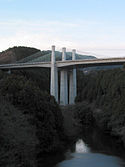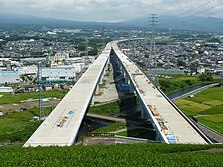Shin Tōmei Highway
| Shin Tōmei Highway in Japan | |

|
|
| Basic data | |
| Operator: |
Central Nippon Expressway Co., Ltd. NEXCO 中 日本 |
| Start of the street: |
Gotemba (until 2020 Ebina ) ( 35 ° 16 ′ N , 138 ° 55 ′ E ) |
| End of street: |
Hamamatsu (until 2015 Toyota ) ( 34 ° 50 ′ N , 137 ° 33 ′ E ) |
| Overall length: | 162 km (254 km in 2020) |
| Shin Tōmei Highway near Fuji | |
The Shin Tōmei highway ( Japanese 新 東 名 高速 道路 , Shin Tōmei Kōsokudōro , dt. "New Tōmei highway") is a 162-kilometer highway on the main island of Honshū in Japan that has been partially opened since 2012 . It runs about 10 km further inland and parallel to the longer Tōmei motorway , which connects Tokyo and Nagoja , and is intended to relieve this as currently the most important east-west motorway and to be completed by 2020 on a total length of 254 kilometers. The motorway is tolled and operated by the Central Nippon Expressway Co., Ltd. ( 中 日本 高速 道路 株式会社 , Naka-Nihon Kōsokudōro Kabushiki Gaisha , NEXCO Naka-Nihon ( NEXCO 中 日本 ), English NEXCO Central Japan ) operated.
Planning, implementation and expansion
After the route was determined in 1987, the planning extended to the start of construction in 1995. After 17 years of construction, the first 162 km long section in Shizuoka Prefecture between Gotemba in the east and Mikkabi ( Kita-ku district of Hamamatsu ) in West to be opened. The expansion in the west to the city of Toyota in Aichi Prefecture is to be completed by 2015 and in the east to the city of Ebina in Kanagawa Prefecture by 2020 . Currently, the highway is connected to the Tōmei highway at its ends.
| Aichi prefecture | Shizuoka Prefecture | Kanagawa Prefecture | ||||||||||||||
| Toyota | Shinshiro | Hamamatsu | Iwata | Kakegawa | Shimada | Fujieda | Shizuoka | Fujinomiya | Fuji | Numazu | Susono | Gotemba | Hadano | Isehara | Atsugi | Ebina |
| until 2015 | since 2012 | by 2020 | ||||||||||||||
Due to the route chosen further inland, the Shin Tōmei highway should be less susceptible to possible earthquakes and tsunamis triggered by them than the Tōmei highway, which had to be partially closed after the Tōhoku earthquake in 2011 . To optimize fuel consumption and to ensure safety, the maximum gradient was limited to 2% (Tōmei motorway 5%) and the minimum curve radius increased to 3,000 m compared to the Tōmei motorway (300 m). The tunnel lighting and traffic monitoring were also improved compared to the Tōmei motorway, the number of helicopter emergency landing sites is 12 (Tōmei motorway: 2).
To realize this in the very mountainous area, it was necessary to lead the motorway through a large number of tunnels and over several bridges and viaducts . In addition to the landscape, the strong earthquake hazard in the region had to be taken into account. In the interests of the economic viability of this non-state, toll motorway, cost efficiency was an important criterion. State-of-the- art construction and construction techniques were used for this, such as the use of an extradosed bridge , prestressed concrete box girder bridges with additional inclined pressure struts to support the cantilevered carriageway slabs and the combination of prestressed concrete structures with steel supporting structures to minimize the dead weight. The eight bridges listed in the table below have received the Tanaka Award from the Japan Society of Civil Engineers (JSCE) for excellence in bridge construction.
| bridge | location | Length in m | execution | Tanaka Award |
|---|---|---|---|---|
| Miyakodagawa Bridge | Hamamatsu |
268 | Extradosed bridge | 2001 |
| Shibakawa Viaduct | Fujinomiya |
461 | Prestressed concrete box girder bridge | 2003 |
| Warashinagawa Bridge | Shizuoka |
1055/813 1 | Girder bridge | 2003 |
| Fujikawa Bridge | Fuji / Fujinomiya |
365/381 1 | Prestressed concrete arch bridge | 2004 |
| Katsurashima Viaduct | Fujieda |
216 | Prestressed concrete box girder bridge | 2005 |
| Uchimaki Viaduct | Shizuoka |
1048/1024 1 | Prestressed concrete box girder bridge | 2006 |
| Yamakiri Viaduct No. 1 | Shizuoka |
717/709 1 | Prestressed concrete box girder bridge | 2007 |
| Sarutagawa Bridge and Tomoegawa Bridge |
Shizuoka |
610/479 2 | Prestressed concrete truss bridge | 2009 |
business
In the first six months after the opening of the 162 km long section, the volume of traffic was distributed in roughly equal parts on the two parallel Tōmei motorways in this area and increased by a total of around 16% to 84,800 vehicles per day. The volume of traffic on the older Tōmei highways could thus be reduced by 40% to 43,800 vehicles per day (73,300 vehicles per day in the same period in 2011). As a result, there were only eleven traffic jams of more than ten kilometers on both motorways , compared to 148 on the Tōmei motorways in the same period in 2011. The average travel speed increased slightly, the number of traffic accidents decreased by around 10% .
Web links
Individual evidence
- ↑ a b c d Sections of the Shin Tōmei Highway. ( Memento of October 27, 2013 on the Internet Archive ) Central Nippon Expressway Company Limited (NEXCO 中 日本, in Japanese).
- ↑ a b Press release on the postponement of the opening of the section to Toyota. Central Nippon Expressway Company Limited, July 23, 2014 (NEXCO 中 日本, in Japanese), accessed July 26, 2014.
- ↑ Planning and construction of the Shin Tōmei highway. ( Memento of October 27, 2013 on the Internet Archive ) Central Nippon Expressway Company Limited (NEXCO 中 日本, in Japanese).
- ^ A critical role for the Shin-Tomei. The Japan Times , April 18, 2012, accessed June 16, 2013.
- ^ NEXCO Central - Annual Report 2012 (Opening of the Shin (New) Tomei Expressway). ( Memento of May 31, 2014 in the Internet Archive ) Central Nippon Expressway Company Limited (NEXCO 中 日本, PDF file; 2.7 MB), accessed on June 21, 2013.
- ↑ Technologies used in the construction of the Shin Tōmei highway. Central Nippon Expressway Company Limited (NEXCO 中 日本, in Japanese), accessed June 15, 2014.
- ↑ a b Miyakodagawa Bridge. Central Nippon Expressway Company Limited (NEXCO 中 日本, PDF file in Japanese; 2.7 MB); Extra-dosed Bridges Designs (Miyakodagawa Bridge). ( Memento of July 14, 2014 on the Internet Archive ) CTI Engineering Co., Ltd .; each accessed on June 15, 2014.
- ↑ Awards of the JSCE for the Shin-Tōmei-Autobahn. Central Nippon Expressway Company Limited (NEXCO 中 日本, in Japanese); Tanaka Award 2000-2011. Japan Society of Civil Engineers (JSCE); each accessed on June 15, 2014.
- ↑ Shibakawa Viaduct. Central Nippon Expressway Company Limited (NEXCO 中 日本, PDF file in Japanese; 2.8MB), accessed June 15, 2014.
- ↑ Warashinagawa Bridge. Central Nippon Expressway Company Limited (NEXCO 中 日本, PDF file in Japanese; 2.4MB), accessed June 15, 2014.
- ↑ Fujikawa Bridge. Central Nippon Expressway Company Limited (NEXCO 中 日本, PDF file in Japanese; 2.3MB), accessed June 15, 2014.
- ↑ Naoki Hagiwara, Akio Kasuga: DESIGN AND CONSTRUCTION OF THE KATSURASHIMA VIADUCT - PRESTRESSED CONCRETE CORRUGATED STEEL WEB BOX GIRDER BRIDGE WITH RIBS AND STRUTS. (PDF file; 639 kB), accessed on June 21, 2013.
- ↑ Uchimaki Viaduct. Central Nippon Expressway Company Limited (NEXCO 中 日本, PDF file in Japanese; 3.3 MB); Second Tomei Expressway Uchimaki Viaduct. KAJIMA CORPORATION, September 2003 (in Japanese); each accessed on June 15, 2014.
- ↑ Yamakiri Viaduct No. 1. Central Nippon Expressway Company Limited (NEXCO 中 日本, PDF file in Japanese; 1.9 MB), accessed June 15, 2014.
- ↑ FY2009 Tanaka Award - Sarutagawa Bridge and Tomoegawa Bridge for the New Tomei Expressway. Japan Society of Civil Engineers (JSCE) (PDF file; 2.2MB), accessed June 21, 2013.
- ^ Highway Economic Effects Research and City Logistics in Japan. Road Bureau; Ministry of Land, Infrastructure, Transport and Tourism (MILT) Japan 2012 (PDF file; 8.5 MB), accessed June 24, 2013.




